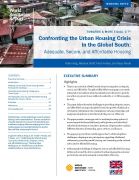Confronting the Urban Housing Crisis in the Global South: Adequate, Secure, and Affordable Housing

It’s clear that there’s a massive lack of affordable housing worldwie – McKinsey estimates that this affects 330 million urban households, and the number will grow as the urban population does. This working paper explores three main hurdles to addressing the gap, particularly for the urban poor:
1) Poor-quality housing far from work options
2) Excessive attention to homeownership, as rental options are often much more relevant to the poor
3) Inappropriate policies and regulations, which push poor people to a city’s fringes
The paper describes approaches from the global South that have successfully responded to these challenges. An example of a comprehensive approach to improving housing quality is the Favela Bairro programme in Rio de Janeiro, which gave residents the right to use informal settlements, using the “adverse possession” stipulation of the Brazilian constitution. While land tenure was not completely granted, the housing upgrading was part of a package of job access, health care, and other policies, which enhanced tenure security.
An example of shifting attention from homeownership to rentals is the increasing legitimation of backyard rental units (“granny flats”) in Johannesburg. These have been subject to controversy over sub-standard construction materials and practices, as well as the potential for overcrowding and exploitation. However, the formalization of backyard rental units in Gauteng Province has increased access to affordable housing and basic services, while giving renters and landlords a stronger incentive to improve the quality of these shelters.
As for converting under-used property into affordable, well-located housing, one example from Cochabamba is of an innovative housing finance model. There, a community land trust known as the María Auxiliadora Community manages 420 families on property that it owns but cannot sell for a profit. The trust is run by women in rotating roles.
This discussion leads to three recommendations for city priorities:
1) Upgrade informal settlements in a genuinely participatory manner.
2) Support rentals by shifting the balance of subsidies to the housing sector, create policies that benefit renters, and implement a wide variety of rental models.
3) Make use of unused inner-city land for housing, through a combination of facilitating planning processes, financial incentives, and governance structures.
An overarching point tying these recommendations together relates to the need to go beyond just technical responses to housing shortages. As the working paper concludes,
Moving the focus beyond buildings and infrastructure to connections between people and organized networks will move communities toward better housing for the under-served. It will also create better housing markets, better quality of life, more opportunities, and more economic activity—all of which strengthen communities and cities.
Available from:
https://wri.org/publication/towards-more-equal-city-confronting-urban-ho...
Further reading:
Environment and Urbanization (1997), “The struggle for shelter”, Vol 9, No 1, available at http://journals.sagepub.com/toc/eaua/9/1.
Environment and Urbanization (2008), “Finance for housing, livelihoods and basic services”, Vol 20, No 1, available at http://journals.sagepub.com/toc/eaua/20/1.
Environment and Urbanization (2009), “Securing land for housing and urban development”, Vol 21, No 2, available at http://journals.sagepub.com/toc/eaua/21/2.
Hasan, Arif (2015), “Land contestation in Karachi and the impact on housing and urban development”, Environment and Urbanization Vol 27, No 1, pages 217–230, available at http://journals.sagepub.com/doi/full/10.1177/0956247814567263.
Book note prepared by Christine Ro
Search the Book notes database
Our Book notes database contains details and summaries of all the publications included in Book notes since 1993 - with details on how to obtain/download.
Use the search form above, or visit the Book notes landing page for more options and latest content.
For a searchable database for papers in Environment and Urbanization, go to http://eau.sagepub.com/

